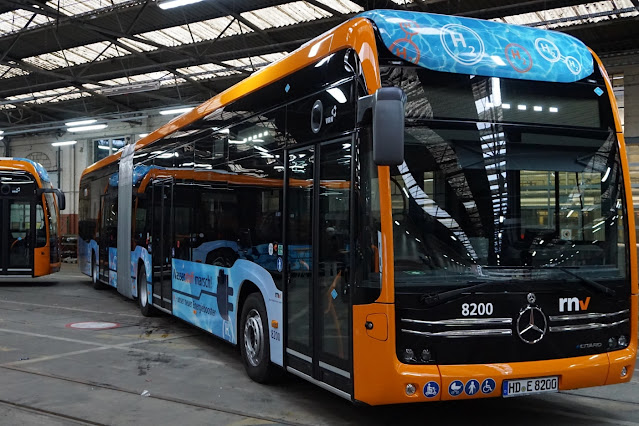Why the eCitaro G fuel cell bus is the best choice for low-emission public transport
Mercedes-Benz has recently delivered the first three of 48 fully electric eCitaro articulated buses with a 60 kW fuel cell as a range extender to Rhein-Neckar-Verkehr GmbH (rnv), a public transport operator in the Rhine-Neckar region of Germany. These buses are the world’s first series-production vehicles of their kind, and they offer a range of up to 400 kilometers on one charge, making them ideal for urban traffic in Mannheim and Heidelberg.
What are the benefits of fuel cell buses?
Fuel cell buses use hydrogen as an alternative fuel to electricity, which can be generated from renewable sources such as water electrolysis. Unlike battery-electric buses, which need to be recharged at charging stations, fuel cell buses can refuel at hydrogen stations, which are more widely available and convenient. Fuel cell buses also have a longer range than battery-electric buses, which means they can cover more distances without stopping.
Fuel cell buses have several advantages over battery-electric buses, such as:
- They have a lower environmental impact, as they produce no tailpipe emissions and only water vapor as a by-product.
- They have a higher energy density, which means they can store more energy in a smaller volume and weight.
- They have a faster refueling time, which means they can resume service quickly after refueling.
- They have a lower maintenance cost, as they have fewer moving parts and less wear and tear.
How does the eCitaro G fuel cell bus work?
The Mercedes-Benz eCitaro G fuel cell bus is based on the eCitaro solo bus, which was introduced in 2019 as the world’s first battery-electric city bus. The eCitaro solo bus has a range of up to 200 kilometers on one charge and can seat up to 12 passengers. The eCitaro G fuel cell bus adds a 60 kW fuel cell stack to the rear of the vehicle, which converts hydrogen into electricity and water. The electricity powers an electric motor that drives the vehicle's rear axle. The water is stored in tanks under the floor of the vehicle.
The eCitaro G fuel cell bus has several features that enhance its performance and efficiency, such as:
- It has an integrated cooling system that prevents overheating of the hydrogen tanks and components.
- It has an intelligent control system that optimizes the operation of the fuel cell stack and monitors its status.
- It has an emergency stop function that shuts down both engines in case of fire or collision.
- It has an air conditioning system that uses fresh air from the outside instead of recirculating air inside.
What are rnv’s plans for using these buses?
rnv is one of Germany’s leading public transport operators, serving over 1.5 million passengers daily across Mannheim-Ludwigshafen-Heidelberg metropolitan area. rnv aims to convert its entire vehicle fleet to locally emission-free drives by 2032, using battery- and hydrogen-powered vehicles. rnv ordered these eCitaro G fuel cell buses in October 2022 from Daimler Buses, which is setting up its production site for city buses in Mannheim.
rnv plans to use these buses for regular service in Mannheim and Heidelberg, where there is high demand for public transport due to population growth and urbanization. The eight other buses will be used in Ludwigshafen am Rhein, with potential for expanding the public transport network. In addition, rnv has an order option for an additional 27 eCitaro G fuel cell vehicles by mid-2025.
rnv hopes that these buses will provide reliable, comfortable and sustainable mobility solutions for its customers and contribute to reducing greenhouse gas emissions and improving air quality in its region.
Conclusion
The Mercedes-Benz eCitaro G fuel cell bus is a groundbreaking innovation that combines electric power with hydrogen technology to offer low-emission urban transport solutions. These buses are part of rnv’s ambitious plan to make its public transport fleet fully emission-free by 2032. By using these buses, rnv hopes to enhance its service quality and customer satisfaction while also supporting Germany’s transition to climate neutrality. @via https://linktr.ee/panorica.





